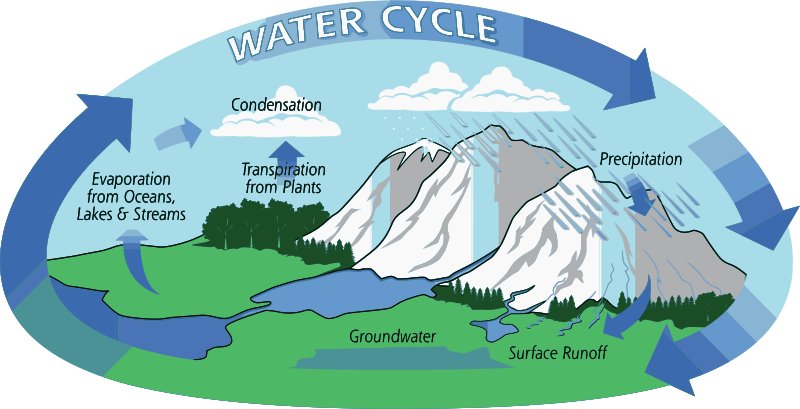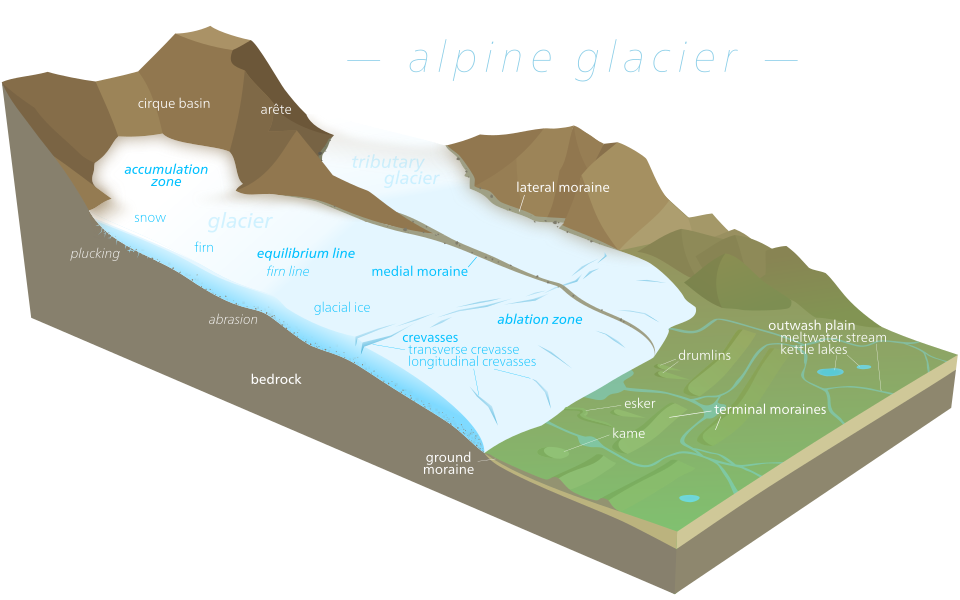AQA Specification focus:
‘Processes driving change in the magnitude of water stores: evaporation, condensation, cloud formation, precipitation, cryospheric processes at various scales.’
AQA A-Level Geography requires understanding of how key physical processes influence the magnitude of global water stores through energy exchange and atmospheric interactions.
Evaporation
Evaporation is a fundamental process that reduces the magnitude of surface water stores (such as oceans, lakes, and rivers) by converting liquid water into water vapour.
Evaporation: The process by which liquid water is converted into water vapour by the addition of heat energy.
This process is influenced by several factors:
Solar radiation: Higher incoming solar energy increases evaporation rates.
Air temperature: Warmer air can hold more moisture, promoting evaporation.
Humidity: Low humidity increases the evaporation potential as dry air has a greater capacity to absorb vapour.
Wind speed: Wind moves saturated air away from the water surface, maintaining a vapour gradient that encourages continued evaporation.
Surface area: Larger water surfaces evaporate more quickly.
Evaporation is most significant over oceans, contributing to atmospheric moisture content and the global hydrological cycle.

This vector diagram illustrates the evaporation, condensation, and precipitation stages of the water cycle, showing how water moves between the Earth’s surface and the atmosphere. It also includes flows like runoff and transpiration (beyond this subsubtopic) for broader context. Source
Condensation
Condensation occurs when water vapour in the atmosphere cools and changes into liquid water, contributing to the formation of clouds.
Condensation: The conversion of water vapour to liquid water when air is cooled to its dew point.
This phase change:
Releases latent heat, warming the surrounding air and fuelling atmospheric motion.
Occurs most commonly when warm, moist air is forced to rise and cool (e.g. due to orographic uplift or frontal convergence).
Results in cloud formation, which plays a key role in weather systems and water store redistribution.
Cloud Formation
Clouds form when condensation occurs around aerosol particles (also called condensation nuclei) in the atmosphere.
Key mechanisms for cloud formation include:
Convection: Surface heating causes air to rise, cool, and condense.
Frontal uplift: Warm air is forced over cold air along a front, causing condensation.
Orographic uplift: Air is forced over topography like mountains.
Convergence: Airflows meet and are forced to rise.
Clouds vary in type and structure depending on:
Altitude (e.g. cumulus vs cirrus)
Moisture content
Stability of the atmosphere
The extent and duration of cloud formation influence precipitation potential and atmospheric moisture storage.
Precipitation
Precipitation refers to any form of water that falls from the atmosphere to the Earth's surface, including rain, snow, sleet, and hail.
Precipitation: The transfer of atmospheric water to the ground in liquid or solid form.
Precipitation is a major input to surface and subsurface water stores and varies spatially and temporally due to:
Air mass origin and movement
Topography
Seasonality
Climatic zones
Factors influencing the amount and type of precipitation include:
Temperature: Determines whether precipitation falls as rain or snow.
Cloud type and vertical extent: Thicker clouds are more likely to produce rain.
Air pressure systems: Low-pressure systems favour uplift and rainfall; high-pressure systems are usually dry.
Precipitation affects both short-term fluxes (such as runoff and infiltration) and long-term storage (such as aquifers and glaciers).
Cryospheric Processes
The cryosphere refers to all the frozen water parts of the Earth system, including glaciers, ice caps, sea ice, permafrost, and snow cover. Cryospheric processes regulate long-term water storage and seasonal fluxes.
Key cryospheric processes include:
Accumulation
Snowfall and freezing add to ice and snow stores.
Accumulation is most significant in high latitudes and high altitudes.
Ablation
Melting, sublimation, and calving reduce cryospheric water storage.
Seasonal ablation contributes to meltwater runoff, which feeds rivers and groundwater.
Sublimation: The direct change from solid ice to water vapour without becoming liquid.
Permafrost Thaw
As global temperatures rise, permafrost (permanently frozen ground) begins to thaw.
This releases water into soil systems and increases runoff, altering local and regional hydrology.
Glacial Retreat
Global warming has caused widespread glacial shrinkage, decreasing long-term water stores and increasing short-term runoff.

This featured cross-sectional diagram of an alpine glacier shows the accumulation zone (where snow and ice build up) and the ablation zone (where melting and sublimation occur), highlighting the key cryospheric processes. It also includes landforms like cirques and moraines, which go beyond the subsubtopic’s direct focus on mass transfers. Source
Cryospheric changes operate across multiple spatial and temporal scales:
Seasonal melt leads to spring floods.
Long-term glacial retreat affects sea level and river baseflows.
Interaction Between Processes
These physical processes are interconnected:
Evaporation adds moisture to the atmosphere, which cools and condenses to form clouds.
Clouds may produce precipitation, feeding surface stores.
In colder regions, precipitation may fall as snow, contributing to the cryosphere.
Seasonal and climatic variation affects all stages, from evaporation potential to cryospheric mass balance.
Together, these processes drive dynamic changes in the magnitude of Earth's water stores, influencing hydrological patterns on local, regional, and global scales.
FAQ
Aerosols act as condensation nuclei, providing surfaces for water vapour to condense into cloud droplets.
Without sufficient aerosols, condensation is less efficient and fewer cloud droplets form, potentially limiting cloud development and reducing rainfall. Natural aerosols include sea salt, dust, and pollen, while human-made sources include sulphates and soot from combustion.
High concentrations of aerosols can lead to smaller but more numerous droplets, delaying precipitation and forming longer-lasting clouds.
The type of precipitation determines how quickly water enters surface or subsurface stores.
Rain contributes immediately to surface runoff and infiltration.
Snow and hail accumulate and delay water input until melt conditions occur.
Freezing rain can create surface ice, limiting infiltration temporarily.
The timing and intensity of melt (e.g. snowmelt) significantly affect seasonal water availability and flood risks.
Cloud type affects how much and how quickly precipitation occurs.
Cumulonimbus clouds are tall and vertically developed, often producing heavy rainfall and thunderstorms.
Nimbostratus clouds are layered and grey, leading to steady, prolonged rainfall.
Cirrus clouds are high and thin and do not generate precipitation.
Vertical extent, water content, and uplift strength all influence how efficiently clouds can produce rainfall.
Latent heat released during condensation fuels atmospheric motion and enhances weather systems.
When water vapour condenses into liquid droplets, it releases stored heat energy:
This warms the surrounding air.
Warmer air becomes less dense and rises further.
This can enhance convection and promote cloud growth or storm development.
Latent heat is essential in driving feedback loops within the atmosphere.
Cryospheric processes operate differently due to variations in climate and elevation.
In polar regions:
Ice sheets and permafrost dominate.
Changes are often slow but widespread and long-term (e.g. Antarctic melting).
In mountain regions:
Glaciers and seasonal snow are key.
Processes like accumulation and ablation respond more quickly to temperature shifts, leading to rapid seasonal runoff changes.
Altitude and temperature gradients control how water is stored and released.
Practice Questions
Identify and describe one physical factor that influences the rate of evaporation from a surface water store. (3 marks)
Mark Scheme (3 marks total):
1 mark for identifying a relevant physical factor (e.g. air temperature, wind speed, humidity, solar radiation, surface area).
1 mark for a basic description of how the factor affects evaporation (e.g. “Higher temperatures increase evaporation”).
1 mark for developing the explanation (e.g. “because warmer air can hold more water vapour, allowing more water to evaporate”).
Example full answer (3 marks):
Air temperature. Higher temperatures increase evaporation because warmer air can hold more water vapour, allowing more liquid water to be converted into gas.
Explain how changes in cryospheric processes can influence the magnitude of global water stores. (6 marks)
Mark Scheme (6 marks total):
Award 1–2 marks for each valid point or developed explanation.
Indicative content may include:
1 mark: Identification of a relevant cryospheric process (e.g. accumulation, ablation, permafrost thaw, glacial retreat).
1 mark: Basic explanation of how the process alters water storage (e.g. "Melting ice reduces stored frozen water").
1 mark: Development with a specific consequence or linkage (e.g. “and increases runoff into rivers, altering surface water levels”).
Up to 3 points can be awarded depending on the depth of explanation.
Example full answer (6 marks):
Glacial retreat reduces the amount of water stored in the cryosphere. As glaciers melt, more water enters rivers and oceans, increasing surface water stores. Permafrost thaw releases previously frozen water into the soil and groundwater systems, changing subsurface water availability. Ablation processes like melting and sublimation reduce long-term storage in ice while increasing short-term runoff.

